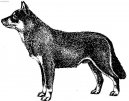Lapponian herder (Dog standard)
Lapponian herder is a docile, calm, friendly, energetic and willing to serve. barks readily when working.
FCI-Standard N° 284 / 12. 03. 1999 / GB
LAPPONIAN HERDER
(Lapinporokoira)
TRANSLATION : Finnish Kennel Club.
ORIGIN : Finland.
DATE OF PUBLICATION OF THE ORIGINAL VALID STANDARD : 12.03.1999.
UTILIZATION : Reindeer herder.
CLASSIFICATION F.C.I. : Group 5 Spitz and primitive types.
Section 3 Nordic Watchdogs and Herders.
Without working trial.
BRIEF HISTORICAL SUMMARY : For hundreds of years the Lapps have used dogs of the same type as Lapponian Herder as reindeer herders. Acceptance to the breed register was started in the 1950’s. At that time the modern Finnish Lapphund and the Lapponian Herder were still recognized as the same breed. The Lapponian Herder was separated into its own breed 10.12.1966, as it had been noted that two different reindeer herding breeds existed.
GENERAL APPEARANCE : A herding spitz, medium SIZEd, clearly longer than the height at the withers. The bone and muscles are strong. The dog is muscular, however must not give the impression of being heavy. The sex should be clearly stamped. The COAT is suitably adapted for the arctic climate.
IMPORTANT PROPORTIONS : The length of the BODY is about 10% longer than the height at the withers. The depth of the BODY is about half of the height at the withers.
BEHAVIOUR / TEMPERAMENT : Docile, calm, friendly, energetic and willing to serve. Barks readily when working.
HEAD : Elongated; the muzzle is slightly shorter than the skull.
CRANIAL REGION :
Skull : Only slightly convex. The frontal furrow is marked and the superciliary ridges are clearly defined.
Stop : Gently sloping.
FACIAL REGION :
Nose : Preferably black, yet harmonizing with the COAT COLOUR.
Muzzle : The nasal bridge is straight. Viewed from above and in profile the muzzle tapers evenly towards the nose.
Lips : Tight.
Jaws/Teeth : Jaws and teeth are strong. Scissor bite. Normal dentition.
Cheeks : The zygomatic arches are clearly marked.
Eyes : Preferably dark in COLOUR, yet harmonizing with the COAT COLOUR. Lively and set rather apart. Oval shaped. The expression is keen, in bitches also devoted.
Ears : Pricked, medium in length, set rather apart, rather broad at set-on. The inside of the ear is covered with profuse HAIR, particularly at the base.
NECK : Strong and medium in length, set smoothly into the shoulders. Without dewlap.
BODY :
Withers : Marked.
Back : Strong and muscular.
Loin : Short and muscular.
Croup : Rather long and slightly oblique.
Chest : Deep, long and spacious, not very broad. The ribs are clearly arched.
Underline : Gently tucked up.
TAIL : Medium in length, low set and covered with profuse HAIR. In repose the TAIL is hanging; in MOVEMENT it is held in a loose curve, but may not raise over the back. The TAIL action may also be circular.
LIMBS
FOREQUARTERS :
GENERAL APPEARANCE : Powerful, attached to the BODY with strong muscles, yet free in MOVEMENT. Muscular and well angulated. Viewed from the front straight and parallel.
Shoulders : Oblique and muscular.
Elbows : Turning neither inwards nor outwards, close to the BODY, pointing straight backwards.
Forearm : Vertical.
Carpus : Sinewy and flexible.
Pastern : Seen in profile slightly oblique, enabling the flexible MOVEMENT.
Fore FEET : Rather oval with all sides, also underneath, covered with dense HAIR. The toes are well arched, the pads elastic and thick.
HINDQUARTERS :
GENERAL APPEARANCE : Well angulated. Viewed from behind straight and parallel.
Upper thigh : Rather long and broad with well developed muscles.
Stifle : Pointed forward, the angulation is clearly marked.
Hock joint : Set rather low; the angulation is clearly marked.
Metatarsus : Rather short, vertical and parallel.
HindFEET : As front FEET. Preferably without dewclaws.
GAIT / MOVEMENT : Free, flexible, effortless and sound. The trot is tireless. At a fast trot tends to single-track.
SKIN : Tight overall without wrinkles.
COAT
HAIR : The outer COAT is of medium length or long, straight, rather erect and harsh. The underCOAT is fine and dense. The HAIR is often more profuse and longer on the NECK, chest and on the backside of the thighs.
COLOUR : Black in different shades, even greyish or dark brown with a lighter shade than the basic COLOUR, greyish or brownish COLOUR markings often on HEAD, the lower parts of the BODY and legs. White markings on NECK, chest and legs are permitted. The underCOAT is black, greyish or brownish.
SIZE:
Height at withers : Ideal height for males 51 cm,
Ideal height for females 46 cm.
With a tolerance of ± 3 cm.
FAULTS : Any departure from the foregoing points should be considered a fault and the seriousness with which the fault should be regarded should be in exact proportion to its degree.
Males not masculine and females not feminine.
Very light eyes in black dogs.
Ears with slack tips (tipped ears).
TAIL curled or curved over the back.
Soft, wavy or flat COAT.
Without underCOAT.
ELIMINATING FAULTS :
Aggresive or overly shy.
Overshot or undershot mouth.
Drop ears.
Any dog clearly showing physical or behavioural abnormalities shall be disqualified.
N.B. : Male animals should have two apparently normal testicles fully descended into the scrotum.
Source: FCI >>> |
